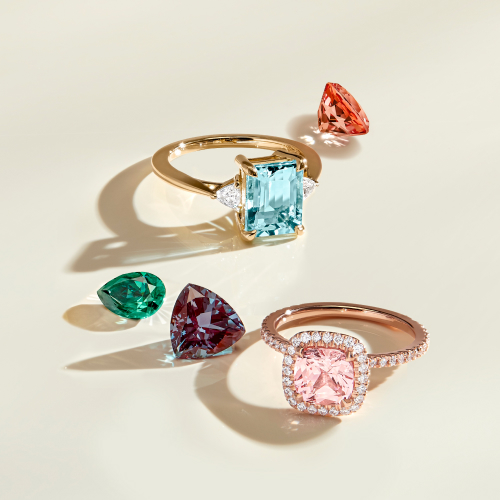Understanding the connection between zodiac signs and birthstones opens up a world where astrology meets gemology. While traditional birthstones are commonly associated with calendar months, zodiac birthstones align specifically with astrological date ranges, offering a more personalized approach to selecting meaningful gemstones.
Birthstones by Zodiac
Zodiac birthstones and monthly birthstones represent two distinct approaches to connecting gemstones with personal identity and meaning. While monthly birthstones are associated with calendar months and follow a standardized list adopted by jewelers, zodiac birthstones are linked to astrological signs and their specific date ranges, which often span across two different months.
The key difference lies in their underlying philosophy and purpose. Monthly birthstones have both traditional and modern versions for some months, and are relatively simple to determine based on one’s birth month. In contrast, zodiac birthstones are chosen to align with each zodiac sign, focusing more on the traits associated with each sign.
This distinction can lead to interesting variations as to which stone might be considered “yours.” For instance, someone born in January would traditionally receive garnet as their monthly birthstone. However, if they were born between January 20 and February 18, their zodiac birthstone would actually be amethyst, as this is the stone associated with the sign of Aquarius. While there is often overlap between zodiac and monthly birthstones, they’re not always the same due to the misalignment of zodiac signs and calendar months, as well as the different criteria used for selecting stones in each system.
Capricorn (December 22 – January 19)
- Zodiac Birthstone: Garnet
- Symbolism: This deep red gem symbolizes protection, strength, and balance, making it perfect for Capricorns who value stability and honesty.
Aquarius (January 20 – February 18)
- Zodiac Birthstone: Amethyst
- Symbolism: Known for promoting clarity, intuition, and calm, this purple stone complements the innovative and intellectual nature of Aquarius.
Pisces (February 19 – March 20)
- Zodiac Birthstone: Aquamarine
- Symbolism: This light blue stone symbolizes tranquility and clarity, calming the mind and helping clear communication – perfect for the sensitive and empathetic Pisces.
Aries (March 21 – April 19)
- Zodiac Birthstone: Diamond/Bloodstone
- Symbolism: Known for its unmatched brilliance and hardness, the diamond symbolizes strength, courage, and eternal love, reflecting the bold and dynamic nature of Aries.
Taurus (April 20 – May 20)
- Zodiac Birthstone: Emerald
- Symbolism: This vibrant green gem symbolizes love and wisdom, bringing renewal and patience to the loyal and nurturing Taurus.
Gemini (May 21 – June 20)
- Zodiac Birthstone: Pearl
- Symbolism: Symbolizing purity and tranquility, pearls bring balance and calm to the adaptable and social Gemini.
Cancer (June 21 – July 22)
- Zodiac Birthstone: Ruby
- Symbolism: This vibrant red stone symbolizes passion and protection, bringing strength and courage to the sensitive Cancer.
Leo (July 23 – August 22)
- Zodiac Birthstone: Peridot
- Symbolism: This green stone symbolizes strength and creativity, bringing positive energy and protection to the bold and charismatic Leo.
Virgo (August 23 – September 22)
- Zodiac Birthstone: Sapphire (Blue)
- Symbolism: This blue stone symbolizes wisdom and purity, bringing mental clarity and focus to the analytical and diligent Virgo.
Libra (September 23 – October 22)
- Zodiac Birthstone: Opal
- Symbolism: Known for its unique play of colors, opal symbolizes hope and creativity, representing the harmonious and artistic nature of Libra.
Scorpio (October 23 – November 21)
- Zodiac Birthstone: Topaz
- Symbolism: This golden stone symbolizes strength and wisdom, bringing clarity and focus to the passionate and determined Scorpio.
Sagittarius (November 22 – December 21)
- Zodiac Birthstone: Tanzanite
- Symbolism: This blue-violet stone symbolizes transformation and intuition, bringing balance and harmony to the adventurous and philosophical Sagittarius.
There’s no strict rule about which system to follow. Many people choose to wear both types of birthstones, as each offers different benefits and meanings. The choice ultimately comes down to personal preference and which stone or system resonates more strongly with the individual.
FAQ
Do birthstones go by month or zodiac?
Birthstones can be determined by either calendar month or zodiac sign. While monthly birthstones follow the traditional Gregorian calendar, zodiac birthstones align with astrological date ranges. This dual system offers flexibility in choosing stones that resonate with your personal identity. You can choose to follow either system or incorporate both for a more comprehensive connection to your gemstones.
What is my zodiac birthstone?
Determining your zodiac birthstone is a straightforward process that begins with identifying your zodiac sign based on your birth date. The zodiac calendar is divided into twelve distinct periods: Capricorn (December 22 – January 19), Aquarius (January 20 – February 18), Pisces (February 19 – March 20), Aries (March 21 – April 19), Taurus (April 20 – May 20), Gemini (May 21 – June 20), Cancer (June 21 – July 22), Leo (July 23 – August 22), Virgo (August 23 – September 22), Libra (September 23 – October 22), Scorpio (October 23 – November 21), and Sagittarius (November 22 – December 21).
Once you’ve identified your zodiac sign, finding your corresponding birthstone is simple. Capricorns are associated with garnet, Aquarians with amethyst, Pisceans with aquamarine, Aries with diamond, Taurus with emerald, Gemini with pearl, Cancer with ruby, Leo with peridot, Virgo with blue sapphire, Libra with opal, Scorpio with topaz, and Sagittarius with tanzanite. Unlike traditional monthly birthstones, which are tied to calendar months, zodiac birthstones are specifically chosen to complement the qualities and characteristics of each astrological sign, making them particularly meaningful for those who connect with their zodiac attributes.
Still interested in learning more about birthstones? Check out our other Birthstone Guides: Birthstone Chart, Birthstone Colors, Birthstone Meanings, Zodiac Birthstones, Most Expensive Birthstones, Rarest Birthstones, January Birthstone, February Birthstone, March Birthstone, April Birthstone, May Birthstone, June Birthstone, July Birthstone, August Birthstone, September Birthstone, October Birthstone, November Birthstone, December Birthstone, Alexandrite Guide, Aquamarine Guide, Emerald Guide, Garnet Guide, Pearl Guide, Sapphire Guide, Topaz Guide






